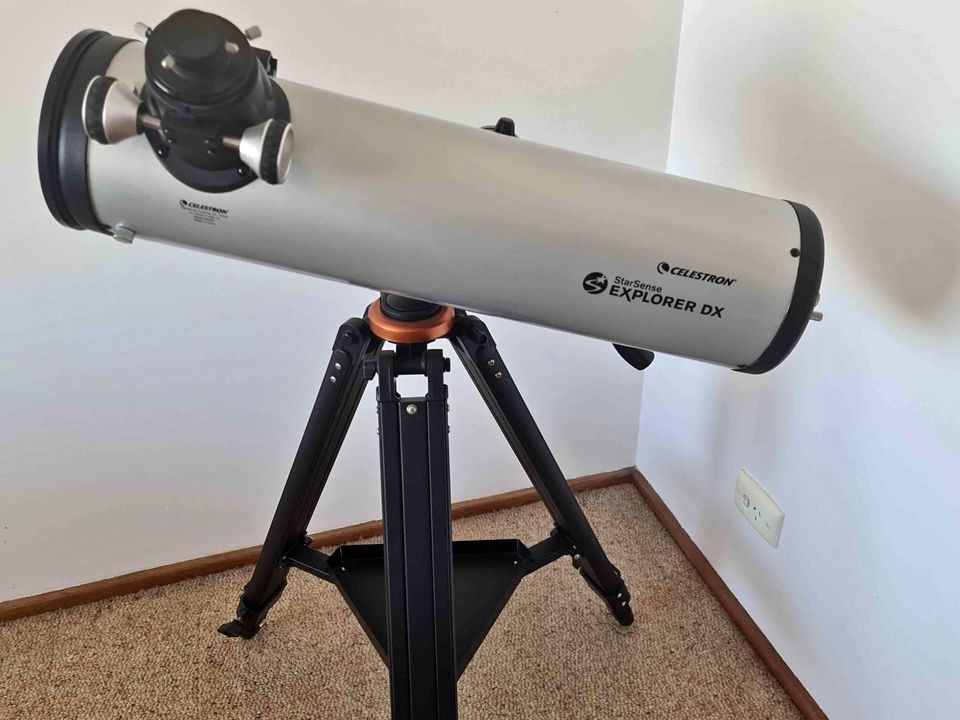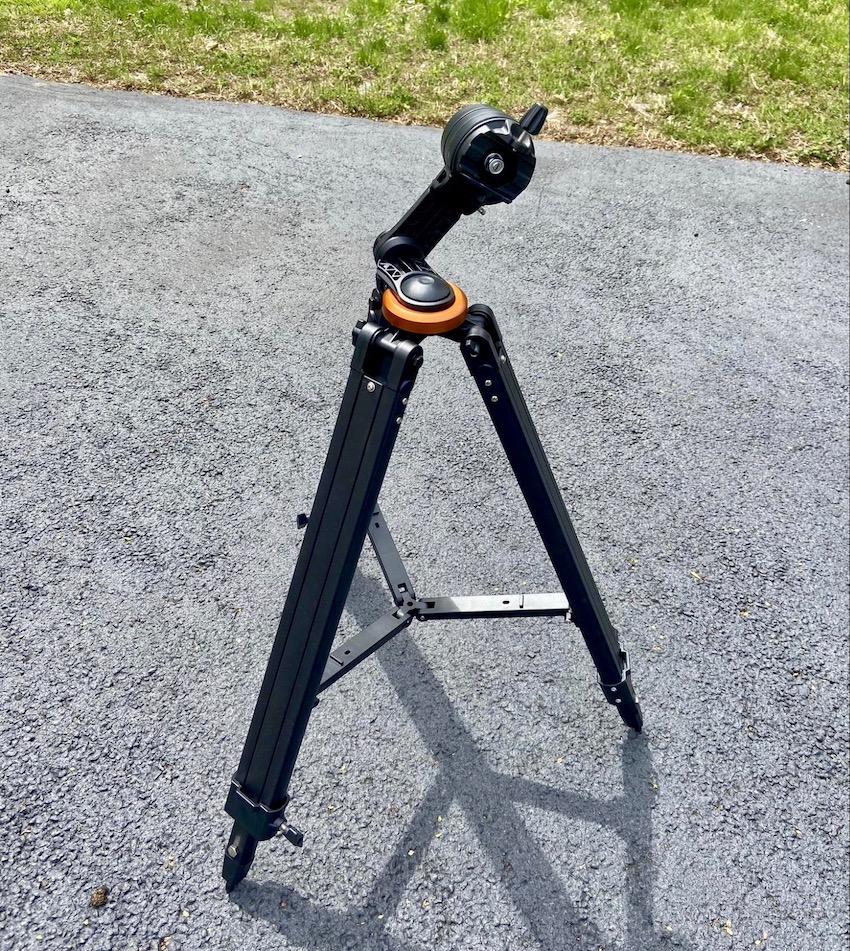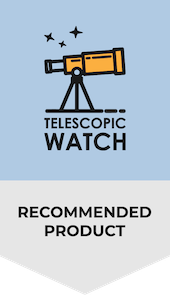The Optical Tube
The StarSense Explorer DX 130 AZ is a 130mm (5.1”) f/5 Newtonian reflector with a focal length of 650mm. An f/5 Newtonian will have coma at the edge of the field of view when you use a wide-field, 2” eyepiece, but the bigger issue at this fast focal ratio is the aberrations induced in lower-quality wide-angle eyepieces by the angle of the light rays. This can manifest mainly as edge-of-field astigmatism, which looks a lot like coma but actually has to do with the eyepiece. The DX 130 AZ does have a 2” focuser, so you could use 2” wide-angle eyepieces and/or a coma corrector with it, but this is somewhat overkill. The included low-power eyepiece already gets you a field of over 2 degrees; a wider-angle 1.25” ocular gives you 2.5 degrees; and a 2” ocular could get you a nearly 4-degree field, albeit one tainted with coma.
Being a Newtonian reflector, the DX 130 AZ does need to be collimated, though whether you’ll actually need to make adjustments often really depends on how well you treat the scope. Collimation isn’t that difficult, but you will probably need at least a basic homemade collimation cap to do it – check out our collimation guide for more info. The primary mirror, which is usually what you will need to adjust, requires no tools, while the secondary mirror can be tilted with a hex key (not included).

The StarSense Explorer DX 130 AZ attaches to its mount with a standard Vixen-style dovetail bar, which is a universally standard rail that fits many other astronomical mounts, though many mounts won’t put the eyepiece/focuser in a comfortable position, and you would need tube rings and a longer, separate dovetail bar to make the DX 130 AZ optical tube comfortable to use. When removed from its mount, the DX 130 AZ’s optical tube easily fits into a backpack or standard carry-on suitcase.
The StarSense Explorer Technology & App
The StarSense Explorer technology is essentially a simplified version of the popular astrophotography and research technique of plate solving—using a short exposure of a star field with an image-matching tool and database of astronomical images to determine where in the sky the scope is pointed. Rather than using a proper camera and computer, or hardware encoders that are aligned by aiming the scope at stars for calibration, the StarSense Explorer makes things simpler and cheaper by taking advantage of the expensive precision instruments you already own, namely the ones inside your smartphone. Since you’re moving the scope to different targets frequently, your battery would be depleted from constantly shooting short exposures and referencing them to a cloud database. The StarSense Explorer technology uses only a few snapshots of the sky (taken via your phone camera with a mirror/bracket attached to the mount) and then guesses where you’re pointed using your phone’s internal gyroscopes.
The more well-leveled the tripod is, the more accurately the bracket is aligned to the scope, and the fancier/newer the phone is, the more accurate the StarSense Explorer will be.
Accessories
The StarSense Explorer DX 130 AZ comes with two mysterious, mostly-plastic eyepieces (usually marketed as either “Super” or Kellner variants), both of which are 1.25” and feature fields of view of around 55 degrees. These are in fact Konig eyepieces with glass lenses, and while their performance is not perfect in a fast scope like the DX 130 AZ, they are quite good. The focal lengths are 25mm and 10mm, yielding 26x and 65x magnification, respectively. You’ll almost certainly want additional eyepieces—mainly at the higher end, since optimal planetary views are usually found at 100x or above, and a 5” telescope can handle up to 250x magnification—but the two included oculars are a good start.
Any telescope needs a finder, even if it’s computerized, and the StarSense Explorer DX 130 AZ is no exception. A standard “StarPointer” red dot finder fitting into an interchangeable Vixen/Synta-type finder shoe is provided and works well for aiming the scope with or without the StarSense Explorer app activated.
Mount

The StarSense Explorer DX telescopes both use a simple, generic “AZ3” mount, sold, rebranded, and repackaged by several different companies, attached to a standard square-tubed aluminum tripod. There are slow-motion controls on both axes, but making fine adjustments with them tends to be difficult as the gearing has a lot of slop and backlash. This can take some getting used to. Extending the tripod legs also tends to make for a less-than-stable setup; keeping the legs retracted and observing while seated would be a good idea. The tripod comes with a hefty accessory tray that’s actually useful, with plenty of room for your eyepieces, filters, flashlight, and other tools.
Should I buy a used Celestron StarSense Explorer DX 130 AZ?
The biggest issue with buying a used StarSense Explorer DX 130 AZ is that either the smartphone bracket may be missing or the unlock codes for the app have already been used. This makes the scope rather unpalatable as it is essentially a naked 130mm f/5 reflector, and a tabletop Dobsonian of the same size and capabilities is a lot cheaper than even the typical used price rate for a DX 130 AZ. However, provided the scope is properly equipped and the StarSense Explorer technology is usable, a lightly used scope is a good deal. Be sure to check the condition of the mirror coatings, the condition and completeness of the accessories, and to avoid any tube with severe dents that impede it from being collimated or parallel with the mount’s altitude axis.
Alternative Recommendations
The StarSense Explorer DX 130 AZ is, of course, not the best in its price range when it comes to value. If you aren’t overly fond of the StarSense Explorer tech and tripods, consider one of the following.
- Fully computerized, best value, scopes in the similar price range:
The Sky-Watcher Virtuoso GTi 150P has more aperture than the DX 130 AZ and can be either pushed manually or slewed automatically across the sky using the SynScan or SkySafari app on your smartphone, or used manually with no impediment to the GoTo functions. It also, of course, automatically tracks objects for you. GTi 150P is also our most favorite scope in the price range of DX 130AZ. A 130mm f/5 version is also available with the same features, at a marginally lower price with the same features. And stripped-down, manual-only but otherwise identical versions (the Heritage 150P and 130P) are also available at significantly lower prices.
- 6″ Dobsonian options at similar price range:
If you must have something free-standing and don’t care as much about portability, a full-sized 6” f/8 manual Dobsonian such as the StellaLyra 8”, Bresser Messier 6” f/8 Planetary Dobsonian, or Sky-Watcher 6” Traditional is a similarly good choice.
- Similar optical performance, but fully manual and significantly cheaper:
Those with a low budget who want similar performance to the DX 130 AZ might want to consider the Zhumell Z130 or one of the previously mentioned Skywatcher Heritage 150P or 130P tabletop scopes.
- Monstrously valued scopes at higher budget groups:
If your budget is larger, the various 8” and 10” Dobsonians (including Celestron’s own StarSense Explorer 8” and 10” models) will blow away the DX 130 AZ or a 6” reflector with their huge apertures and simple mountings.
Aftermarket Accessory Recommendations
The StarSense Explorer DX 130AZ is decently well-equipped with its StarSense Explorer technology and pair of provided eyepieces, but nonetheless, you will undoubtedly want to acquire multiple additional eyepieces to expand your magnification options. For medium power, a 16mm Ultra Wide Angle (UWA) eyepiece (41x) offers an immersive and sharp option, while a 15mm redline/goldline (43x) serves as a decent budget-friendly alternative.
A 10mm UWA (65x) or a 9mm redline/goldline (72x) delivers sharper views, a wider field of view, and a more comfortable experience compared to the StarSense Explorer DX 130AZ’s stock 10mm ocular. For higher magnification, a 4mm planetary eyepiece or a 4mm UWA (163x) is an excellent choice. We would recommend the UWAs over cheaper SWA/redline oculars if you can afford them given the manual nature of the scope’s mount; the well-corrected and wider field of the UWAs will allow you to adjust the aim of the telescope less frequently.
Additionally, it is advisable to have a Cheshire or other collimation tool at your disposal to ensure accurate collimation with any telescope such as the StarSense Explorer DX 130AZ in order to get the sharpest possible views.
Last but not least, a narrowband Ultra High Contrast (UHC)/OIII nebula filter can significantly enhance your observations of nebulae, such as the Orion Nebula, when using the StarSense Explorer DX 130AZ or any other telescope, by improving contrast and thus the visibility of fainter details at the eyepiece. Furthermore, it provides enough contrast improvement to reveal previously invisible targets, like the Crab Nebula and Veil Nebula supernova remnants, which become visible using this telescope under dark skies.
What can you see with the Celestron StarSense Explorer DX 130?
A 130mm reflector can show you a lot, especially under dark skies, and the StarSense Explorer technology makes it very quick to find a lot of objects to see even in a short amount of time (though the longer you linger on a target, the more you’re likely to see).
The StarSense Explorer DX130 will, of course, show you the phases of Venus and Mercury, the ice caps on Mars, and the rings of Saturn. You’ll also be able to see lunar mountains, a few dark markings and dust storms on Mars’ surface, Jupiter and Saturn’s cloud belts, the Great Red Spot in Jupiter’s clouds and the Cassini Division in Saturn’s rings, and the 4 large Galilean moons circling Jupiter. The Galilean moons appear as tiny disks when they transit across Jupiter, and have dark shadows following them as they simultaneously cast eclipses over Jupiter’s cloud tops. Saturn sports up to half a dozen moons.
In almost any telescope, Uranus is merely a greenish-blue fuzzy dot, and its moons are beyond the reach of only a 5” aperture. Neptune may be hard to distinguish from a star at all due to its tiny angular size, but you should be able to locate it with the StarSense Explorer app, and its moon Triton is just barely bright enough to be within the DX 130’s grasp under optimal viewing conditions.
The quality (and number) of deep-sky objects you can view with any telescope is, of course, dependent on your light pollution conditions. Even under light-polluted city skies, however, the StarSense Explorer DX 130 AZ can show you bright open and globular star clusters. Under suburban skies or better, emission nebulae like Orion (M42) or the Swan (M17) come into their own, especially with a UHC filter, and open star clusters become jaw-dropping. A 5” telescope like the DX 130 AZ can also begin to resolve the outer members of the brightest globular star clusters like M13, M22, and M15, or show you dust lanes in galaxies like M31, M82, and M64. You’re not going to be seeing spiral arms in any galaxies, however, and even the most obvious details like dust lanes will be hard to spot under light-polluted conditions.
For really jaw-dropping – or at least recognizable – views of galaxies and globular star clusters, you do need a bigger telescope than a 130mm. It’s up to you whether to decide on using the StarSense Explorer DX 130 as a stepping stone up to those bigger instruments, or to plunge right into a big Dobsonian at first—keep in mind that Celestron offers the StarSense Explorer tech with well-made 8” and 10” Dobs too, either of which will blow away the DX 130 under any conditions in all kinds of viewing.
Keep in mind that when first using the StarSense Explorer DX 130, you’ll want to make sure to set your phone screen to dim (and hopefully red) to preserve your dark adaptation, and to always get away from any other nearby sources of direct light if you want to be able to see deep-sky objects in detail.


